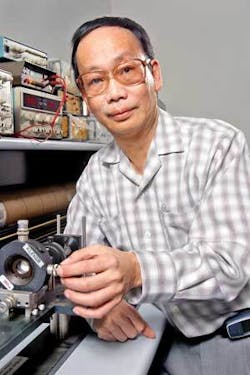OPTICAL MATERIALS: Polymer has strong electro-optic effect

Electro-optic (E-O) devices are used in applications ranging from high-speed fiberoptic communications to radar and navigation. Organic E-O materials, which have high E-O coefficients in comparison to inorganics, are often essential to these devices. Scientists at Psi-Tec (Wilmington, DE) have developed a new organic material whose E-O coefficient was experimentally determined to be up to seven times greater than that for the highest performance conventional organic materials. In addition, the material, which the company calls Perkinamine-NR, has high photochemical and thermal (greater than 300°C) stability. This combination of properties may lead not only to better-performing E-O devices, but also simpler devices with eased electrical requirements.
The Psi-Tec researchers compared Perkinamine-NR with two of the best performing commercially available benchmark organic E-O materials: DR1 (Disperse Red 1), and CLD (Cheng-Larry Dalton). The coefficient being measured was the electro-optic coefficient (in pm/V) of a nonlinear optical polymeric film. An E-O polymer consists of two parts: a passive polymer matrix such as PMMA or polycarbonate for mechanical stability, and the active polymer molecules (chromophores) that have a strong second-order nonlinear optical effect, explains Ron Genova, Psi-Tec’s CEO.
The so-called r33 measurement technique used by the researchers is a simple reflection technique based on the polarization rotation of a laser beam due to the material’s electro-optic effect (see figure).1 Results of the experiment agree well with those obtained from the more-conventional waveguiding method.
Tests at 1300 and 1550 nm
Tests were conducted using approximately the same molar concentration (4.5% loading) for materials DR1 and CLD as well as Psi-Tec’s Perkinamine-NR. (This relatively low figure for molar loading is important: while higher loadings may give higher E-O coefficients, the low molar loading chosen for this experiment better highlights the differences in response between polymer molecules.) The tests, which were conducted using a 1300 nm source modulated at 1 kHz, produced a value for DR1 of 0.8 pm/V, a value for CLD of 1.8 pm/V, and a 3.7 pm/V value for Perkinamine-NR, according to Genova, who notes that the experimental values are subject to a ±10% imprecision because of spurious modulation modes.
In a separate test at the University of Arizona (Tucson, AZ) in which researchers compared Perkinamine-NR to CLD at 1550 nm, Perkinamine-NR (11.1 pm/V) outperformed CLD (1.7 pm/V) by 700% in the single best peak reading of several readings. Both materials were mixed into PMMA at low concentrations and equal molar loading for the experiment.
The first two generations of these materials developed at Psi-Tec are Perkinamine and Perkinamine-NR; each material has different E-O properties and will be suited for different applications, which range from high-performance telecom and datacom to bioimaging and optical processing, notes Genova. These polymers will be the first commercial organic molecules based on “aromatic gain” theoretical principles (polyheterocyclical structures using cyclic surface conduction), as opposed to the heretofore industry standard “bond-length-alternation” approach (polyene π-bridge conduction).
Psi-Tec simulations suggest that the drive voltages for Perkinamine-NR will be low enough that E-O devices fabricated from the material can be operated directly from radio-frequency-drive integrated circuits, resulting in reductions in device size and cost, says Genova.
REFERENCE
1. C.C. Teng and H.T. Man, Applied Phys. Lett. 56(18) (April 30, 1990).
About the Author
John Wallace
Senior Technical Editor (1998-2022)
John Wallace was with Laser Focus World for nearly 25 years, retiring in late June 2022. He obtained a bachelor's degree in mechanical engineering and physics at Rutgers University and a master's in optical engineering at the University of Rochester. Before becoming an editor, John worked as an engineer at RCA, Exxon, Eastman Kodak, and GCA Corporation.
